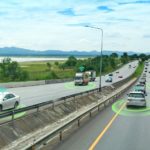Self-driving cars: how and when machines began taking control
Putting a machine at the wheel is an old automotive dream. Now self-driving cars are a closer goal, but it all began with small steps starting in the middle of the twentieth century.

It looks as if the major technology companies have overtaken the automotive giants in the race for the self-driving car. Google (born in 1988), Uber (2009) and Tesla (2003) are elbowing in between and even getting ahead of the classic names in automobiles. It's possible that Waymo, the Google division devoted to automated driving, will be launching a self-driving taxi service before the end of the year in Phoenix, Arizona.
This news, released first by the Bloomberg agency, would be a decisive step on the long road to driverless vehicles. We’re not talking about a couple of decades; we need to go back to the middle of the twentieth century, when the companies that now appear to be on the point of completing the journey didn’t even exist.
The self-driving car has been put together in a certain way, like with a Meccano set, piece by piece. Little by little, machines have been taking over functions inside the vehicle, and they are now at the point of doing it at the steering wheel, thanks to new technologies such as computer vision and the internet of things.
First advance: cruise control
In the long evolution of serial automotive applications, the first thing to be automated was cruise control, in a rudimentary form.
With its Imperial Convertible in 1958, Chrysler was the first manufacturer that dared to bet on the invention developed a few years earlier by the mechanical engineer Ralph Teetor, blind from youth due to an accident. Fed up, as the story goes, by the acceleration and braking by his lawyer, who was also his usual driver, Teetor designed a device that he called Speedostat, for limiting maximum velocity. It was operated by two rudimentary cables. After extensive developments over the years, these systems are electronic, and obviously much more sophisticated.
Some twenty years after humans stopped controlling acceleration in their cars for the first time, another machine began controlling braking. This is ABS, an innovation that was first experimented with in aviation.
At first, it was a luxury product in cars - Mercedes introduced it at the end of the seventies - but since 1 July 2004 it has been required equipment on all passenger cars made in the European Union.

The first thing to be automated was cruise control.
The brains of the automobile
It is not as easy to trace the arrival of artificial ‘intelligence’ in vehicles, but it has been around now for about 35 years. We grant that the ‘brains’ are currently the ECU (for Engine Control Unit), the outcome of extensive efforts in the industry (since even 1939) that generally began to materialise in the eighties, under the aegis of the US company General Motors. Like the human brain, the ECU works with sensors; it uses them to optimise the performance of the engine.
Once cars began having ‘brain mass’, the next essential step on the road to self-driving cars was the arrival of connectivity, the capacity to communicate with the outside. A product was developed in 1996 with OnStar, also developed by General Motors, that uses GPS, a tool practically confined to the military up to that time. When the air bags in a vehicle are deployed, the system automatically contacts a responsible party, which in turn passes on the information to emergency services. It may look pretty rudimentary after over twenty years, but OnStar, a service that, while evolved, is still active, represents a milestone: cars began to communicate without the need of human intervention.
Vehicles took another step forward when they began to be aware of what was going on around them, and even began to take actions accordingly. This was with the Lane Departure Warning System at the beginning of the twenty-first century, which warns when the vehicle is moving out of its established lane. Japanese makers were the first to mass market them, and only in Asian countries: the pioneer was Nissan in 2001, followed by Toyota a year later.
The development of the self-driving car over the last fifteen years has been spectacular, thanks to the growth of new technologies such as the internet of things, artificial intelligence, incredibly precise sensors, 360 degree artificial vision... Little improvements that took decades before are now just a matter of years. But this doesn't mean that these small steps haven’t opened up the path; just as Alan Turing, the father of cryptography, had a lot to do with the development of the ‘blockchain’, smart cars took their first steps long before the internet was conceived.